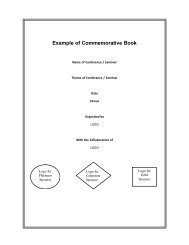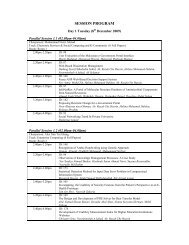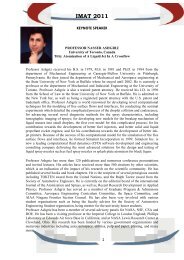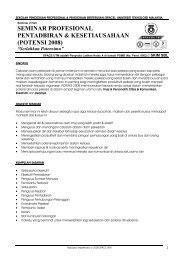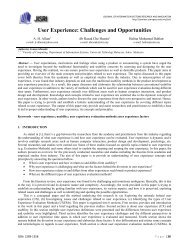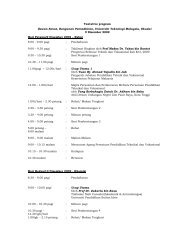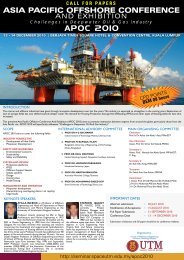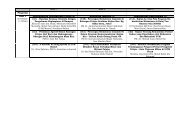Download Full Text - space seminar main page
Download Full Text - space seminar main page
Download Full Text - space seminar main page
- No tags were found...
You also want an ePaper? Increase the reach of your titles
YUMPU automatically turns print PDFs into web optimized ePapers that Google loves.
JOURNAL OF INFORMATION SYSTEMS RESEARCH AND INNOVATIONhttp://<strong>seminar</strong>.utm<strong>space</strong>.edu.my/jisri/Investigating Intelligent Workflow and Intelligent Agents inSoftware FlexibilityShokooh Abedi Dehkordi 1e-mail: Shokooh_abedi_2008@yahoo.comHossein Monem 2e-mail: ali.monem@gmail.comAuthor(s) Contact Details:1, 2Islamic Azad University, Fars Science and Research Branch, Shiraz, IranAbstract—Developing software systems are easier to design, cheaper to <strong>main</strong>tain, and more robust therefor softwareengineering has been seen as a continuous quest in developing software systems. Recently, most major software companieshave either acquired or developed workflow components for integration into their existing software platforms. Softwareflexibility shows that indicate if the software is easy to change .Workflow management by modeling business processesexplicitly and managing business processes as data helps achieve software flexibility that they are much easier to modifythan conventional program modules, while workflow systems must be adaptive in order to effectively support today’sdynamic, uncertain, and error-prone collaborative work environments. In a workflow environment an innovative techniqueof achieving software flexibility was investigated to achieve a robust, cost effective and flexible software. Software can bemade more robust, more cost effective to <strong>main</strong>tain, and easier to change by incorporating workflow technology andintelligent agent techniques into modern information systems. In this paper two steps investigation consist of first: criticaland deep investigation on the software flexibility issues, and second, an investigation on the integrated system architecturethat include of workflow coordination mechanisms and the agent-based decision making capabilities, more insight wasprepared for further researches in this disciplines.Keywords – Intelligent Workflow Techniques ، Software Flexibility ،Intelligent Workflow Management ، IntelligentWorkflow System1. INTRODUCTIONThe central role of flexibility in software design and implementation in software design is recognized by classic andcontemporary literature. Structured design, modular design, object-oriented design, software architecture, design patterns,and component-based software engineering, play the <strong>main</strong> role in software flexibility. Software flexibility has effect on<strong>main</strong>tenance cost it is capable of handling certain exceptions in an automated manner.Two problems in the current notion of ‘software flexibility’ are: The absence of reliable metrics and the second ismisconceived that is as an absolute quality. The definition of software flexibility in IEEE is: The ease with which a systemor component can be modified for use in applications or environments other than those for which it was specificallydesigned [20]However, what is software flexibility and how to measure it aren't be clearly defined. Although intuitively softwareflexibility is understood as the ability to respond to changes, and is occasionally used for evaluating the qualityof software, but there isn't yet a good definition for software flexibility because:First, the “flexibility” is a word with rich meanings. It is sometimes used interchangeably with other terms, such asadaptability, plasticity, elasticity, agility and versatility, etc. Second, to the author’s knowledge, there are no welldefinedand unified software flexibility measurement criteria. Third, software flexibility, similar to material flexibility, isone of software’s internal properties. Though, how easy the software is to use, how long it takes to make changes onISSN: 2289-1358 P a g e | 40
JOURNAL OF INFORMATION SYSTEMS RESEARCH AND INNOVATIONhttp://<strong>seminar</strong>.utm<strong>space</strong>.edu.my/jisri/existing software, etc., to some degree reflect software flexibility properties, such external behaviors do not reveal theessence of software flexibility [16].Software engineering has been seen as a continuous quest of developing software systems that are easier to design, cheaperto <strong>main</strong>tain, and more robust [14]. Data-oriented software architecture, object-oriented language, component-basedsoftware development, and document-based interoperability have been achieved in software engineering. Dataindependence and process independence are more important than others, when the data structures modified, dataindependence became a measure of the robustness of business applications. Relational database became dominant in thedatabase market because of the achievement of significant data independence. When the process model redesigned, processindependence became a measure of the robustness of business applications. In the last few years the drive towards moreprocess independence has led to the proliferation of workflow systems in the software industry. Very recently, most majorsoftware companies have either acquired or developed workflow components for integration into their existing softwareplatforms. Workflow management by modeling business processes explicitly and managing business processes as datahelps achieve software flexibility they are much easier to modify than conventional program modules. Workflowmanagement systems enable reuse of process templates, robust integration of enterprise applications, and flexiblecoordination of human agents and teams. In this paper, it is studied additional techniques based on intelligent agents toincorporate more flexibility in conventional workflow management systems. The research goal is to further improvesoftware flexibility by achieving more process independence [4].2. LITERATURE REVIEWA. Software FlexibilityIssues in the management of changing business processes from strategic, operational, and system perspectives have beenstudied by researchers [2, 6, 8]. Process changes can occur often. Many business processes are not well understood anddifficult to formalize, leading to mismatches between the system specifications and real needs of the business. In addition,there are often exceptions to the basic routines of the business, requiring the system to be robust in order to handle processdeviation from the norm [4].Technology flexibility is defined as the characteristics of technology that allow or enable adjustments or other changes tothe business process [18]. They proposed a measurement framework for technology flexibility that include such factors asmodularity, change acceptance, and consistency in the structural flexibility dimension, and rate of response, expertise, andcoordination of actions in the process flexibility dimension.System adaptability and system versatility are two software flexibility concepts [21]. System adaptability is the capabilityto modify the system to cope with major changes in business processes with little or no interruption to business operations.System versatility (or system robustness) is the capability of the system to allow flexible procedures to deal with exceptionsin processes and procedures.In this paper, the concepts of software flexibility and apply the results to the development of flexible process technology isextended and unify by means of intelligent workflow techniques.B. Flexible Workflow SystemsAccording to the Workflow Management Coalition (WFMC), a Workflow management system is “a system thatcompletely defines, manages and executes workflows through the execution of software whose order of execution is drivenby a computer representation of the workflow logic.” [19]ISSN: 2289-1358 P a g e | 41
JOURNAL OF INFORMATION SYSTEMS RESEARCH AND INNOVATIONhttp://<strong>seminar</strong>.utm<strong>space</strong>.edu.my/jisri/Researchers in workflow technology and management are concerned with developing flexible workflow systems. Klein,Dellarocas, and Bernstein (2000) claimed that “Workflow systems must be adaptive in order to effectively support today’sdynamic, uncertain, and error-prone collaborative work environments. … Workflow systems currently provide little supportfor adaptive processes. Most do not allow one to modify a process model once it has started executing. Exceptions arehandled by attempting to include the workflow pre-defined conditional branches for all possible contingencies.”Researchers pursue several important directions to achieve workflow flexibility:• Exception handling: Fault tolerance is a key requirement in process support systems including workflowsystems. Hagen and Alonso (2000) presented a solution for implementing more reliable processes by using anexception handling technique as used in programming languages.• Dynamic model evolution: Dynamic workflow change requires the management of changing processmodels. For instance, Ellis and Keddara (2000) addressed the problem of unambiguously specifying processmodel changes, via taxonomy of change modalities and a language for the unambiguous specification ofprocedural change.• Emergent process modeling: Another general approach for dealing with dynamic adaptation is based onpartially specified process models and depends on flexible enactment systems to refine and execute them atthe runtime [15, 9].In this paper, software flexibility is built upon the basic ideas of dynamic workflow management and proposed intelligentworkflow techniques.C. Intelligent Agent perceptionsIntelligent agent technology is one of the fastest growing areas of research and system development in IT [11]. Intelligentagents and multi-agent systems represent a new way of modeling many complex information management and decisiontasks. Agents also represent a new computing environment for designing and implementing complex software systems [12].Intelligent agents refer to autonomous software entities that can navigate heterogeneous computing environments and can,either alone or working with other agents, achieve user-delegated goals.3. Forming Software FlexibilitySoftware flexibility conceptualized in two levels, i.e., technology flexibility and system flexibility. In software flexibility,is referred to the ability of a software application to deal with exceptions to the process model at the runtime and to copewith periodic changes to the process model. By technology flexibility, Software flexibility can be achieved by adopting theright combination of specific modeling paradigm, programming technique, software architecture, and developmentmethodology. This level of flexibility is analogous to the combination of the structural and process dimensions proposedby Nelson et al. (1997), but with less emphasis on the organizational effects. By system flexibility, both systemadaptability and system versatility were discussed by Zhao (1998).The term of hierarchical process management is coined. In a large-scale information system such as a B2B transactionprocessing system, the overall business process consists of many sub processes, including inter-enterprise processes, intraenterpriseprocesses, inter-function processes, and intra-function processes. It is referred to the modeling and execution ofthis process hierarchy as hierarchical process management. In the next section, it is shown that different informationtechniques such as workflow and intelligent agents can be applied to improve the technology flexibility and systemflexibility at the various levels of the process hierarchy [4].ISSN: 2289-1358 P a g e | 42
JOURNAL OF INFORMATION SYSTEMS RESEARCH AND INNOVATIONhttp://<strong>seminar</strong>.utm<strong>space</strong>.edu.my/jisri/4. Intelligent Workflow organizationA. Workflow-Based FlexibilityWorkflow technology is becoming the base of the next generation of enterprise application systems because it enablesbetter flexibility of software systems in several respects: consist of first, specialization of components into functional andprocess components: The workflow model essentially captures the inter-component processes, using a component-basedsoftware development philosophy. Second, in some ways, a regular component such as a database can be seen as afunctional component, while the workflow engine can be considered as a process component. This is the essence ofhierarchical process management. Third, the separation of process design and process execution: The workflow paradigmenables the separation of process design from process execution by managing a process model as a template that can beinstantiated at the runtime. This makes it possible to isolate the change of processes to different levels of the processhierarchy, resulting in reduced process interdependence. As a result, changes to processes can be made faster and cheaper.Forth, interoperability between process components: Given two workflow-coordinated enterprise systems, theinteroperability between the two enterprise systems is turned into the interoperability between two workflow engines. Thishelps improve the speed of establishing, redesigning, and executing the inter-enterprise processes, thus making the overallsystem more flexible when the business relationship between two enterprises undergoing changes [4].B. “Intelligent Agent”-Based FlexibilityIntelligent agent techniques can be applied to improve the flexibility of information systems because of its several inherentfeatures which claimed by Zeng and Zhao (2002) and summarized in this part. These features include of first, specializationthat means intelligent agents can be programmed to follow special instructions with a specific goal from a genericarchitecture. This enables fast building of software components. Second, negotiation, that means intelligent agents cannegotiate with one another to exhibit versatile behaviors in the system that would not be possible through rigid procedures.And last one is coordination that means intelligent agents can be used to build a collaborative community of agents(including both human and software agents) that is more flexible than the typical workflow model.C. Flexibility via Intelligent WorkflowIt is proposed to combine the workflow-based flexibility and the agent-based flexibility to achieve significantly improvedoverall software flexibility. It is referred to this endeavor as flexibility via intelligent workflow. This approach has beenalso expressed by Zeng and Zhao (2002) as following properties.• Inter-enterprise flexibility can be achieved by interoperating workflow engines that each coordinates an intraenterprisebusiness process.• Intra-enterprise flexibility can be realized by means of the workflow management paradigm as aforementioned.• Inter-component flexibility is made possible by means of both workflow management and agent-basedcomponents.The next subsection illustrates how these three types of flexibility are achieved under the hierarchical process managementparadigm we propose in this paper.ISSN: 2289-1358 P a g e | 43
JOURNAL OF INFORMATION SYSTEMS RESEARCH AND INNOVATIONhttp://<strong>seminar</strong>.utm<strong>space</strong>.edu.my/jisri/D. Hierarchical Process ManagementFigure 1 illustrates how workflow engines are used to link business processes between two enterprises. The interoperationbetween two enterprises requires a collection of such activities as advertisement of services, negotiation of contracts, andoutsourcing of processes, which has been referred to as cross-flow [17].FIGURE 1 : Inter-enterprise process management (adopted from Zeng and Zhao (2002))Figure 2 shows how to manage inter-department processes by modeling them under one or more workflow systems. Aninter-department process is more stable than an inter-enterprise process because the relative stability of relationships andthe close coordination and planning ability within the same enterprise [4].FIGURE 2 : Inter-department process management (adopted from Zeng and Zhao (2002))Inter-component process can be managed by integrating workflow components with intelligent agent components [4]. Asshown in Figure 3, the coordination process among a community of intelligent agents is more flexible than a regularworkflow coordination process because the interactions between the coordinating agent and the task agents are achievedthrough flexible negotiation in a distributed manner based on a common agent language and program interface.FIGURE 3 : Inter-component process management (adopted from Zeng and Zhao (2002))ISSN: 2289-1358 P a g e | 44
JOURNAL OF INFORMATION SYSTEMS RESEARCH AND INNOVATIONhttp://<strong>seminar</strong>.utm<strong>space</strong>.edu.my/jisri/5. A General Background for Evaluating Software ArchitecturesSoftware <strong>main</strong>tenance cost often constitutes a significant part of the total cost associated with developing and operating asoftware system during its life span. If a software system is more flexible, it can reduce the <strong>main</strong>tenance cost then Softwareflexibility through several ways has major impact on software <strong>main</strong>tenance cost has major impact on software <strong>main</strong>tenancecost. They are consist of: First, a software system is capable of handling certain exceptions in an automated manner then itdeveloped to be flexible, which in turn cuts back the effort and resources that have to be invested to deal with theseexceptions by both the software users and the system development and <strong>main</strong>tenance personnel. Second, in today’scompetitive marketplace, an enterprise typically goes through frequent changes in its ways of dealing with their customersand suppliers. A flexible software system provides a viable alternative in dealing with these types of software <strong>main</strong>tenancecosts since it is easier and more cost-effective to reconfigure and reassemble software components to meet changes in userrequirements. Three possible system architectures are considered in this study: a) a conventional information system inwhich no workflow or intelligent agent techniques will be used, b) a workflow-based information system, and c) anintelligent workflow system that combines workflow and intelligent agent techniques [4].6. CONCLUSIONThe benefits of flexibility are not only intangible but also difficult to quantify, so more quantitative approaches requireevaluate and improve software flexibility. In this paper, some techniques of achieving software flexibility in a workflowenvironment was investigated that enhanced by intelligent agent technology.A general evaluation framework was presented with respect to total software cost which can be used to analyze theeconomic impacts of various types of software architectures. Some general technological and managerial insights areoffered as to the varying degrees of software flexibility and cost implications for conventional software, workflow systems,and the proposed intelligent workflow systems. The general evaluation framework can also serve as a theoretical basis formaking potentially critical software architecture decisions facing virtually all IT adopters [4].REFERENCES[1] Amnon H. Eden, Tom Mens. “Measuring Software Flexibility.” IEE Software, Vol. 153, No. 3 (Jun. 2006), pp. 113–126. London, UK: The Institution of Engineering and Technology.[2] Bowers, John, Graham Button, and Wes Sharrock, "Workflow from within and without", Proc. of the 4 th EuropeanConf. on CSCW, 1995.[3] Chen Huang , Yushun Fan , , “Intelligent Workflow Management: Architecture and Technologies” , Proceedings ofThe Third International Conference on Electronic Commerce(ICeCE2003), Hangzhou Oct. 2003[4] Daniel D. Zeng , J. Leon Zhao , “Achieving Software Flexibility via Intelligent Workflow Techniques”, Proceedingsof the 35th Hawaii International Conference on System Sciences – 2002[5] Deiters, W., T. Goesmann, T. Löffeler, “Flexibility in Workflow Management: Dimensions and Solutions”,International Journal of Computer Systems Science and Engineering, Vol 15, No 5, September 2000, pp. 303-313.[6] Earl, Michael J., “The new and the old of business process redesign”, Journal of Strategic Info. Systems, Vol 3, No.1, 1994, pp. 5-22.[7] Ellis, C. and K. Keddara, “ML-DEWS: modeling language to support dynamic evolution within workflow systems.”Computer Supported Cooperative Work: The Journal of Collaborative Computing, Aug. 2000, vol.9, (no.3-4): 293-333.[8] Ellis, C. and G. Rozenberg, “Dynamic change within workflow systems”, Proceedings of the COOCS 95, Milpitas,CA, USA, 1995.[9] Faustmann, G. “Configuration for adaptation-a human-centered approach to flexible workflow enactment.”Computer Supported Cooperative Work: The Journal of Collaborative Computing, Aug. 2000, vol.9, (no.3-4):413-34.[10] Hagen, C. and G. Alonso, “Exception handling in workflow management systems.” IEEE Transactions on SoftwareEngineering, Oct. 2000, vol.26, (no.10): 943-58.[11] Jennings, N., Sycara, K., and Wooldridge, W. “A roadmap of agent research and development,” Autonomous Agentsand Multi Agent Systems, Vol 1, No 1, July 1998.[12] Joshi, H. and Singh, M. Multiagent Systems on the net. Communications of the ACM, Vol 42, No 3, 1999.ISSN: 2289-1358 P a g e | 45
JOURNAL OF INFORMATION SYSTEMS RESEARCH AND INNOVATIONhttp://<strong>seminar</strong>.utm<strong>space</strong>.edu.my/jisri/[13] Klein, M., C. Dellarocas, and A. Bernstein, “Introduction to the special issue on adaptive workflow systems.”Computer Supported Cooperative Work: The Journal of Collaborative Computing, Aug. 2000, vol.9, (no.3-4):265-267.[14] Knoll, K. and S. L. Jarvenpaa, “Information technology alignment or "fit" in highly turbulent environments: theconcept of flexibility”, Proceedings of the 1994 computer personnel research conference on Reinventing IS, March24 - 26, 1994, Alexandria, VA USA, Pages 1-14.[15] Kumar, A. and Zhao, J. L. “Dynamic Routing and Operational Controls in Workflow Management Systems”,Management Science, Feb. 1999, vol.45, (no.2): 253-72.[16] Limin Shen, Shangping Ren , “Analysis and measurement of software flexibility based on flexible points” ,Published in the Proceedings of Smef – 2006[17] Ludwig, Heiko and Yigal Hoffner, “Contract-based Cross-Organisational Workflows - The CrossFlow Project”,Proceedings of the Workshop on Cross-Organisational Workflow Management and Co-ordination, San Francisco,USA, February 22, 1999.[18] Nelson, K. M. et al., "Technology flexibility: conceptualization, validation, and measurement", Proceedings ofHICSS97.[19] Workflow Management Coalition. The Workflow Reference Model , [WfMC1003] [R] . WFMC TC00-1003 , 1994[20] IEEE. Standard Glossary of Software Engineering Terminology 610.12-1990, Vol.1. Los Alamitos: IEEE Press,1999.[21] Zhao, J. Leon, “Intelligent Agents for Flexible Workflow Systems”, Proceedings of the AIS Americas Conferenceon Information Systems, Baltimore, Maryland, August 14-16, 1998.ISSN: 2289-1358 P a g e | 46



